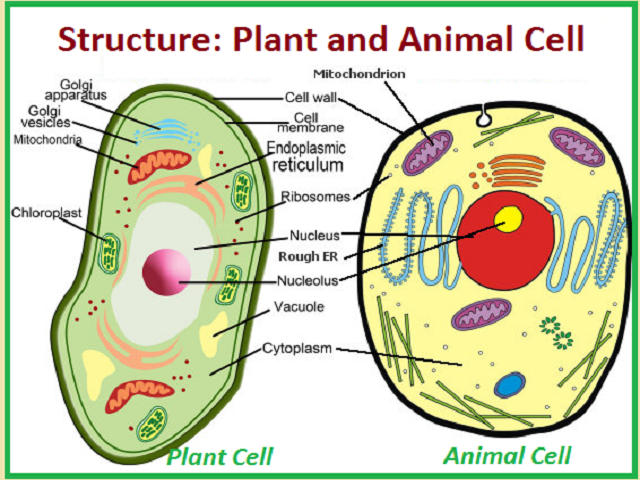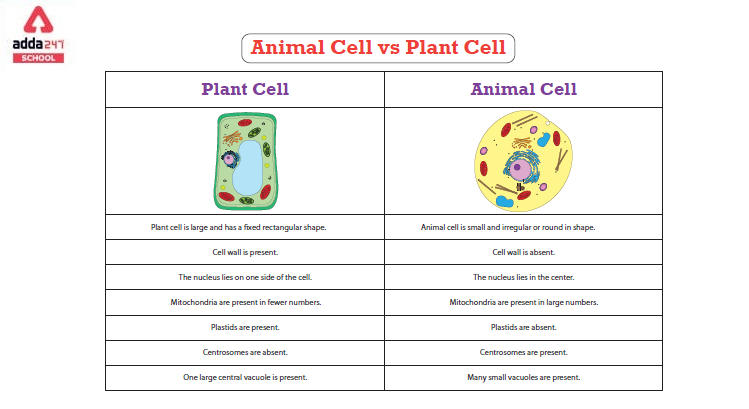Table of Contents
Difference Between Plant cell and Animal cell: The cell is one of the fundamental units of a living body, which is responsible for all metabolic activities. Plants and animals, as we know, are made up of millions of cells that share certain similarities and distinctions. There are many distinctions and similarities between plant and animal cells. Plants and animals have eukaryotic cells, thus their cell architecture and organelles are very similar. Nonetheless, there are significant differences between plant and animal cells. Here we discuss all facts and difference between plant cell and animal cell.
Difference Between Plant cell and Animal cell
The cell is the basic unit of life, and cells are responsible for almost all of life’s functions. Multicellular organisms have a huge number of cells, whereas unicellular species have only one cell. Unicellular organisms are thought to be one of the first forms of life on Earth, with more sophisticated multicellular species subsequently evolving from them. Specialized cells are seen in multicellular organisms. Cell organelles in multicellular organisms are complex. Complex cell organelles are uncommon in unicellular species.
The basic difference between plant cell and animal cell is Plants play the job of producer in an ecosystem, whilst animals play the role of consumer, which explains why their daily activities and functions differ. Not only that, but their cell structures are also diverse. Plants and animals have different cell structures and organelles. They are classified mostly according to their function. Plants and animals differ due to differences in their cell makeup, and as a result, their structure and functions differ as well.
The another difference between plant cell and animal cell is Each cell organelle has a specific purpose, and while some of the cell organelles are found in both plant and animal cells, others may be exclusive to only one.
Each cell organelle has a specific purpose, and while some of the cell organelles are found in both plant and animal cells, others may be exclusive to only one.
It might be the fact that all living species are made up of cells with similar structures, but still, there remain variances in the architectures of plant and animal cells.
The cell membrane, nucleus, mitochondria, and vacuoles are all structures found in both plant and animal cells, however, the cell wall and chloroplasts are two structures that are just present in plants.
Now, we will get to know the main difference between plant cell and animal cell have.
Differentiate Between Plant Cell and Animal Cell Class 9 and 8 Biology
Some important difference between plant cell and animal cell are given below.
- Plant cells have a cell wall. On the other hand, Animal cells lack a cell wall. However, Plants rely on their cell walls for stability.
- Plants use chloroplasts to perform photosynthesis, which allows them to produce food, and thus they have it, however, Animal cells lack chloroplasts.
- Animal cells contain smaller vacuoles (if any) and are irregular or spherical, whereas plant cells have one or more big vacuoles and are square or rectangular in appearance. Large vacuoles assist the plant to maintain its shape and allow it to store water and food for later use.
- A plant cell’s nucleus is present and located on one side of the cell, whereas an animal cell’s nucleus is located in the centre.
- Lysosomes are present in plant cells but are very rare, whereas they are present and can be plentiful in animal cells.
- Centrosomes are not present in plant cells, however, they are present in animal cells.
Both cell types have cytoplasm, as well as ribosomes and the Golgi Apparatus. - Plastids can be found in plant cells, however, they are not seen in animal cells.
- In a plant cell, Cilia is lacking, although it is found in the majority of animal cells.
- Mitochondria are present in plant cells but in fewer numbers than in animal cells.
- A plant cell’s mode of nutrition is largely autotrophic, whereas an animal cell’s mode of nutrition is heterotrophic.
- Plant and animal cells both feature membrane-bound organelles including the endoplasmic reticulum, mitochondria, the nucleus, Golgi apparatus, peroxisomes, and lysosomes, as well as membranes like cytoskeletal elements and cytoplasm. Plant cells have the potential to be larger than animal cells. Animal cells have a normal range of 10 to 30 micrometres, while plant cells have a range of 10 to 100 micrometres.
Differentiate Between Plant Cell and Animal Cell
Plant cells and animal cells are the basic units of life, but there are some differences between the two.
Plant cells have several unique features that animal cells do not have. some points are given below.
- Cell Wall: Plant cells have a cell wall made of cellulose, which provides support and protection for the cell.
- Chloroplasts: Plant cells have chloroplasts, which are organelles that contain chlorophyll and are involved in photosynthesis. Chlorophyll is a pigment that helps plants to capture energy from sunlight and convert it into chemical energy.
- Large Central Vacuole: Plant cells have a large central vacuole, which stores water and other substances. This is important for maintaining the turgor pressure of the cell.
In other way we say, animal cells have several features that plant cells do not have. some points are given below
- Centrioles: Animal cells have centrioles, which are involved in cell division.
- Lysosomes: Animal cells have lysosomes, which are organelles that contain digestive enzymes.
- Cilia and Flagella: Some animal cells have cilia or flagella, which are structures that are involved in the movement.
Difference Between Plant cell and Animal cell with Diagram
Here is a diagram that shows the differences between plant and animal cells:

As you can see from the diagram, plant cells have a more rigid and rectangular shape due to their cell wall, while animal cells have a more rounded shape. Plant cells also have a larger central vacuole and chloroplasts, while animal cells have centrioles and lysosomes.
Plant cell and Animal cell Difference in Hindi
Some difference between plant cell and animal cell in Hindi is given below
कोशिका और पशु कोशिका के बीच अंतर
कोशिका जीवन की मूल इकाई है, और कोशिकाएँ जीवन के लगभग सभी कार्यों के लिए जिम्मेदार होती हैं। बहुकोशिकीय जीवों में बड़ी संख्या में कोशिकाएँ होती हैं, जबकि एककोशिकीय प्रजातियों में केवल एक कोशिका होती है।
एककोशिकीय जीवों को पृथ्वी पर जीवन के पहले रूपों में से एक माना जाता है, और अधिक परिष्कृत बहुकोशिकीय प्रजातियां बाद में उनसे विकसित होती हैं। बहुकोशिकीय जीवों में विशिष्ट कोशिकाएँ देखी जाती हैं। बहुकोशिकीय जीवों में कोशिकांग जटिल होते हैं। एककोशिकीय प्रजातियों में जटिल कोशिका अंग असामान्य हैं।
एक पारिस्थितिकी तंत्र में पौधे उत्पादक की भूमिका निभाते हैं, जबकि जानवर उपभोक्ता की भूमिका निभाते हैं, जो बताता है कि उनकी दैनिक गतिविधियां और कार्य अलग-अलग क्यों हैं। इतना ही नहीं, बल्कि उनकी कोशिका संरचना भी विविध हैं। पौधों और जानवरों में अलग-अलग कोशिका संरचनाएं और अंग होते हैं। उन्हें ज्यादातर उनके कार्य के अनुसार वर्गीकृत किया जाता है। पौधे और जानवर अपने सेल मेकअप में अंतर के कारण भिन्न होते हैं, और परिणामस्वरूप, उनकी संरचना और कार्य भी भिन्न होते हैं।
प्रत्येक कोशिका अंग का एक विशिष्ट उद्देश्य होता है, और जबकि कुछ कोशिका अंग पौधे और पशु कोशिकाओं दोनों में पाए जाते हैं, अन्य केवल एक के लिए अनन्य हो सकते हैं।
प्रत्येक कोशिका अंग का एक विशिष्ट उद्देश्य होता है, और जबकि कुछ कोशिका अंग पौधे और पशु कोशिकाओं दोनों में पाए जाते हैं, अन्य केवल एक के लिए अनन्य हो सकते हैं।
यह तथ्य हो सकता है कि सभी जीवित प्रजातियां समान संरचनाओं वाली कोशिकाओं से बनी होती हैं, लेकिन फिर भी, पौधों और जानवरों की कोशिकाओं की वास्तुकला में भिन्नताएं होती हैं।
कोशिका झिल्ली, नाभिक, माइटोकॉन्ड्रिया और रिक्तिकाएं सभी संरचनाएं हैं जो पौधे और पशु कोशिकाओं दोनों में पाई जाती हैं, हालांकि, कोशिका भित्ति और क्लोरोप्लास्ट दो संरचनाएं हैं जो पौधों में मौजूद हैं।
अब, हम उन मुख्य अंतरों को जानेंगे जो पादप कोशिका और जंतु कोशिका दोनों में होते हैं।
पादप कोशिका और जंतु कोशिका के बीच का अंतर बिन्दुओं में
पादप कोशिकाओं में एक कोशिका भित्ति होती है। दूसरी ओर, पशु कोशिकाओं में कोशिका भित्ति का अभाव होता है। हालांकि, पौधे स्थिरता के लिए अपनी कोशिका भित्ति पर निर्भर होते हैं।
पौधे प्रकाश संश्लेषण करने के लिए क्लोरोप्लास्ट का उपयोग करते हैं, जो उन्हें भोजन का उत्पादन करने की अनुमति देता है, और इस प्रकार उनके पास यह होता है, हालांकि, पशु कोशिकाओं में क्लोरोप्लास्ट की कमी होती है।
जंतु कोशिकाओं में छोटे रिक्तिकाएँ (यदि कोई हो) होती हैं और अनियमित या गोलाकार होती हैं, जबकि पादप कोशिकाओं में एक या अधिक बड़ी रिक्तिकाएँ होती हैं और दिखने में वर्गाकार या आयताकार होती हैं। बड़े रिक्तिकाएं पौधे को अपना आकार बनाए रखने में सहायता करती हैं और बाद में उपयोग के लिए पानी और भोजन को स्टोर करने की अनुमति देती हैं।
एक पादप कोशिका का केंद्रक कोशिका के एक तरफ मौजूद और स्थित होता है, जबकि एक पशु कोशिका का केंद्रक केंद्र में स्थित होता है।
लाइसोसोम पौधों की कोशिकाओं में मौजूद होते हैं लेकिन बहुत दुर्लभ होते हैं, जबकि वे मौजूद होते हैं और पशु कोशिकाओं में भरपूर मात्रा में हो सकते हैं।
सेंट्रोसोम पादप कोशिकाओं में मौजूद नहीं होते हैं, हालांकि, वे पशु कोशिकाओं में मौजूद होते हैं।
दोनों प्रकार की कोशिकाओं में साइटोप्लाज्म, साथ ही राइबोसोम और गोल्गी उपकरण होते हैं।
प्लास्टिड पौधों की कोशिकाओं में पाए जा सकते हैं, हालांकि, वे पशु कोशिकाओं में नहीं देखे जाते हैं।
एक पादप कोशिका में, सिलिया की कमी होती है, हालाँकि यह अधिकांश पशु कोशिकाओं में पाया जाता है।
माइटोकॉन्ड्रिया पौधों की कोशिकाओं में मौजूद होते हैं लेकिन पशु कोशिकाओं की तुलना में कम संख्या में होते हैं।
पादप कोशिका के पोषण का तरीका काफी हद तक स्वपोषी होता है, जबकि एक पशु कोशिका के पोषण का तरीका विषमपोषी होता है।
पौधे और पशु कोशिकाओं में एंडोप्लाज्मिक रेटिकुलम, माइटोकॉन्ड्रिया, न्यूक्लियस, गॉल्जी उपकरण, पेरॉक्सिसोम और लाइसोसोम सहित झिल्ली-बाउंड ऑर्गेनेल, साथ ही साइटोस्केलेटल तत्व और साइटोप्लाज्म जैसी झिल्ली शामिल हैं। पादप कोशिकाओं में पशु कोशिकाओं की तुलना में बड़े होने की क्षमता होती है। पशु कोशिकाओं की सामान्य सीमा 10 से 30 माइक्रोमीटर होती है, जबकि पौधों की कोशिकाओं में 10 से 100 माइक्रोमीटर की सीमा होती है।
Other Related Posts –


 Karnataka SSLC Exam Result 2024 Date, Wh...
Karnataka SSLC Exam Result 2024 Date, Wh...
 MHT CET PYQ Chapterwise PDF- PCB & P...
MHT CET PYQ Chapterwise PDF- PCB & P...
 NBSE HSSLC Result 2024 Out, Nagaland Boa...
NBSE HSSLC Result 2024 Out, Nagaland Boa...















